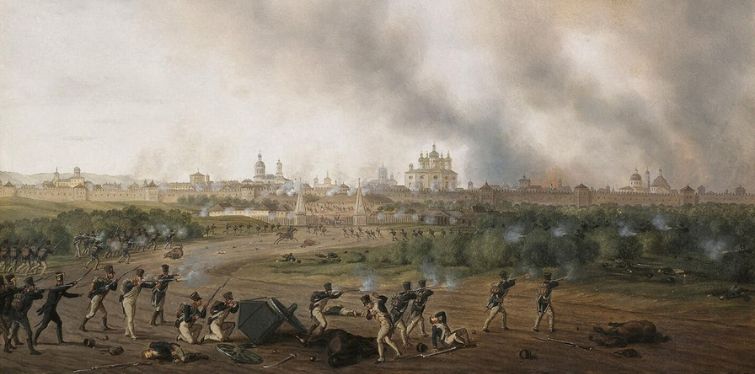This is Part 1 of a three part series presenting a narrative of the course of Napoleon's 1812 campaign, covering the period from the beginning of the campaign to Mikhail Kutuzov's appointment as supreme commander of the Russian army. Check out our existing blog posts on the topic of Napoleon's invasion of Russia, as well as our publishing schedule.
Late in the night of 24 June, while attending a ball at General Bennigsen’s estate in Vilna (Vilnius, Lithuania), Tsar Alexander I of Russia received reports that the Emperor Napoleon had crossed the River Niemen into the territory of the Russian Empire at the head of a large army. Alexander had been anticipating the resumption of hostilities with Napoleonic France and accompanied his army to Vilna in March. The Franco-Russian alliance that had been in effect since the Peace of Tilsit in 1807 had broken apart irrevocably, and both sides were preparing for round two.
Napoleon regarded Tsar Alexander as a wayward ally who had been violating the terms of the Continental System by allowing the British to trade in St Petersburg. He hoped that a quick campaign would bring the Russians to heel. With this in mind, he assembled an army of over 500,000 men to invade Russia. The Grande Armée of 1812 included units from all over Europe, including 100,000 Polish, 50,000 Italians, and tens of thousands of Germans from various kingdoms and principalities. The intention was to intimidate Russia into making peace, or to fight a decisive battle near the border and reach an advantageous settlement with Alexander, perhaps annexing a province or two but primarily to force him back into the Continental System.
Alexander had been making his own plans. The presence of a Napoleonic client state (the Duchy of Warsaw) on Russia’s western border threatened Russia’s security. In 1810, the Tsar appointed General Mikhail Barclay de Tolly to the office of Minister of War and tasked him with reforming the Russian army along French lines. While the Russians considered several strategic plans, Alexander favoured Prussian General Karl von Phull’s plan of constructing a fortified camp at Drissa on the Dvina (northern day Belarus), with the 120,000 strong First Western Army under Barclay de Tolly retreating from Vilna to entice Napoleon to the camp, before the 50,000 strong Second Western Army under Prince Pyotr Bagration would strike in Napoleon’s rear.
As news filtered through to Russian headquarters about the size of Napoleon’s army, it became clear that the initial operational plan was no longer fit for purpose. Nevertheless, the Russian First Army chose to retreat to Drissa in any case, where it transpired that the position was completely inappropriate even had Napoleon’s army been a third of the size. The main priority for the Russians was now to unite Barclay and Bagration’s armies as soon as possible to prevent Napoleon from defeating the two armies in detail. Both armies were to join up at Vitebsk to make a stand. Meanwhile, the Tsar was persuaded to leave headquarters, taking the hapless Phull with him. Before leaving, Alexander told Barclay, “I entrust my army to you. Don’t forget that it is the only army I have. Keep this thought always in your mind." Both men knew that Napoleon could not stay in Russia for long with such a large army.
Naturally, Napoleon had recognised the opportunity to defeat Bagration and Barclay separately. At the head of the main army, Napoleon chased after Barclay’s First Army. He also sent General Oudinot towards St Petersburg, which forced Barclay to detach 30,000 men under General Pyotr Wittgenstein to cover the approaches to the capital city. Meanwhile, Napoleon ordered his right wing, under the overall command of his brother Jerome, King of Westphalia, to pursue Bagration and prevent him from marching north to join Barclay. Not being a professional soldier, Jerome clashed with his most senior subordinate, Marshal Davout, a strict discipliniarian, whose 72,000 strong I Corps accounted for the vast majority of Jerome’s command. After being censured by Napoleon for his laidback attitude – prompted in part by General Platov’s Cossacks inflicting a series of defeats on his cavalry – Jerome chose to return to his Kingdom of Westphalia in early August.
Despite disagreements in the French camp, Davout had just beaten Bagration to the city of Mogilev, cutting him off from Barclay who had already arrived at Vitebsk. On 23 July, Bagration sent half his force under General Nikolay Raevsky to attack the French at Saltanovka – in an effort either to break through to Mogilev or to hold back the French pursuit. During the fierce battle, Raevsky launched a series of attacks but was unable to break through and eventually opted to retreat. The failure of the Second Army to break through at Saltanovka forced Barclay to retreat on the 26th, extricating his army in the middle of the night and leaving the campfires burning. The retreat was carried out so efficiently that the Count de Segur, on Napoleon’s staff, wrote that the Russians had “nothing left behind, not one weapon, nor a single valuable; no trace, nothing in short, in this sudden nocturnal march, which could demonstrate, beyond the bounds of the camp, the route which the Russians had taken; there appeared more order in their defeat than in our victory!”
Barclay’s decision to retreat infuriated Bagration, who labelled him a coward for retreating for several hundred miles and abandoning large tracts of territory to the enemy. Bagration even insinuated that Barclay was guilty of treason. While Barclay was well aware that his main priority was to preserve the army, many of his subordinates in the First Army were equally aggrieved by the constant retreat. Despite this Barclay and Bagration successfully united their armies at Smolensk and the two commanders met on 2 August and made a show of reconciliation by greeting each other arm-in-arm in full view of the army.
The spirit of cooperation between the two Russian commanders soon faded. After being reluctantly persuaded by Bagration to go on the offensive, Barclay led his army northwest and attempted to outmaneouvre Napoleon and retake Vitebsk, but faulty intelligence about the whereabouts of Napoleon’s army caused him to waste considerable time. Meanwhile, Napoleon saw an opportunity to envelop the Russians in Smolensk, by ordering Davout to outflank the Russians to the south, and occupy the Moscow Road.
Bagration’s Second Army had left Smolensk to support Barclay’s operations, but returned to Smolensk when he learned that the city was under threat from Davout. Bagration had detached General Dmitry Neverovsky’s 27th Division to protect the approaches to Smolensk at Krasny. On 14 August, with 10,000 men at his disposal, Neverovsky successfully held back the French vanguard under Murat and Ney, withstanding more than 30 attacks on his position. Despite taking considerable casualties, Neverovsky managed to withdraw with most of his men to Smolensk, where he was joined by General Ivan Paskevich’s 26th Division.
Instead of attacking the relatively small Russian force at Smolensk, Napoleon ordered his army to halt, allowing Bagration and Barclay to to return to the city. On 16 August, Napoleon launched a frontal assault on Smolensk, even though he could easily have outflanked the Russians with his numerically superior army. Perhaps he was afraid that if the Russians were to notice such a manoeuvre, the elusive enemy would once again slip from his grasp – and he was desperate to bring them to battle.
The city was initially defended by Raevsky’s VII Corps, which saw the brunt of the fighting on the first day of the battle. The French managed to occupy a couple of suburbs, but at great cost. Meanwhile, French artillery fire transformed the city and its medieval fortress into a blazing inferno. On the evening of the 16th, Barclay and Bagration decided that the First Army would defend Smolensk while the Second Army would cover the road to Moscow in case Napoleon attempted an outflanking manoeuvre. On the 17th, General Dmitry Dokhturov took over the defence of Smolensk with his VI Corps and Prince Eugen of Wurttemburg’s 4th Infantry Division. Despite considerable losses and much of the city being destroyed, Smolensk remained in Russian hands. Both sides sustained around 10,000 casualties during the battle.
To the consternation of almost all his subordinates, Barclay nevertheless decided it was time to retreat. He was afraid that the First Army would be surrounded at Smolensk and had no wish to repeat the fate of the unfortunate General Mack in 1805. With great reluctance, Dokhturov withdrew his men from the city during the night and burned the bridge across the Dniepr. The First Army was by no means out of danger. In order to avoid presenting a large target to Napoleon, Barclay opted to retreat to the Moscow Road during the night of 18-19 August, dividing his army into two columns.
This complicated manoeuvre did not go to plan, and part of Nikolay Tuchkov’s column found itself within earshot of the French vanguard. Only through desperate fighting on the part of the Russians and no small amount of luck was the First Army saved on the 19th. The Second Army had already retreated along the Moscow Road without waiting for the First. With 3000 men, General Pavel Tuchkov – Nikolay’s younger brother – took up a defensive position at Valutina Gora and held off the French for five hours before Barclay arrived on the scene to direct the action, personally leading infantry columns to counterattack the French. While the First Army was saved, the younger Tuchkov was wounded and taken captive. During the battle, General Junot’s Westphalian Corps crossed the Dniepr behind the Russian left but advanced no further. Junot’s failure to advance has been ascribed to his mental illness, but the marshy terrain also impeded his progress.
Napoleon had remained in Smolensk during the action at Valutina Gora, never expecting to be given the opportunity to cut off half the First Army. With the Russians continuing to retreat, he could remain in Smolensk, spend the remainder of the year consolidating control of Lithuania and Belorussia and preparing for a decisive campaign in 1813. His rear was already threatened from the south by the Russian Army of the Danube under Admiral Pavel Chichagov, while his main army was down to less than 175,000 men as a result of attrition (heat exhaustion, illness, battle casualties) and the necessity of detaching units for garrison duty. Advancing this force any further could invite disaster unless he could quickly bring the Russians to battle again.
Despite being advised to halt his campaign by most of his marshals, Napoleon opted to press on towards Moscow. The scarcity of resources during the winter would have compelled Napoleon to spread his army out very thin with a Russian army and their Cossacks still active in the field. Keen to have another opportunity to do battle with the Russian army, Napoleon was also convinced that the Russians could not abandon Moscow without a fight. From Smolensk, it was only two weeks’ march to Russia’s ancient capital city. It was still possible to defeat the Russians and return home before Christmas.
Meanwhile, Barclay’s position as de facto commander became untenable. After retreating from Smolensk, the claims of cowardice and treachery grew ever louder. Barclay was forced to send away Grand Duke Constantine and General Bennigsen for insubordination. In fact, while the battle was still raging in Smolensk, the Tsar convened a meeting of senior retired officers and court officials to appoint an overall supreme commander. While candidates were proposed, there was only one real choice – General Mikhail Kutuzov, whom the Tsar elevated to the rank of Serene Prince. While the Tsar considered Kutuzov too old and lethargic for the job, he was well aware that the appointment of the veteran would boost morale both at home and in the front lines. The rank and file, desperate to fight Napoleon once more, welcomed news of Kutuzov’s appointment and were convinced that they would soon get their chance.
When Barclay received news that he had been superceded in command, he was busy preparing for another battle, taking up a position at Tsarevo-Zaymishche, some 100 miles to the west of Moscow. By this point the size of both armies had almost reached parity. While Kutuzov had approved of Barclay’s dispositions and ordered the construction of earthworks to continue, soon after he arrived at the position on 29 August – to almost universal jubilation – he decided to retreat. Kutuzov argued that he wanted to join forces with a corps of 15,000 men under General Mikhail Miloradovich, most of whom were raw recruits. Barclay claimed that Bennigsen – back at headquarters as Kutuzov’s chief of staff – told Kutuzov that if he were to fight and win at Tsarevo-Zaymishche, he would have to share credit with Barclay, who had chosen the position. Thus, in spite of Kutuzov’s arrival, the Russian army continued to fall back ever closer to Moscow.
We hope you enjoyed this blog post. If you’re interested in buying some products featuring Russian generals of 1812, please check out our Russian collection, including our Catuzov Tee below!




Share and get 15% off!
Simply share this product on one of the following social networks and you will unlock 15% off!